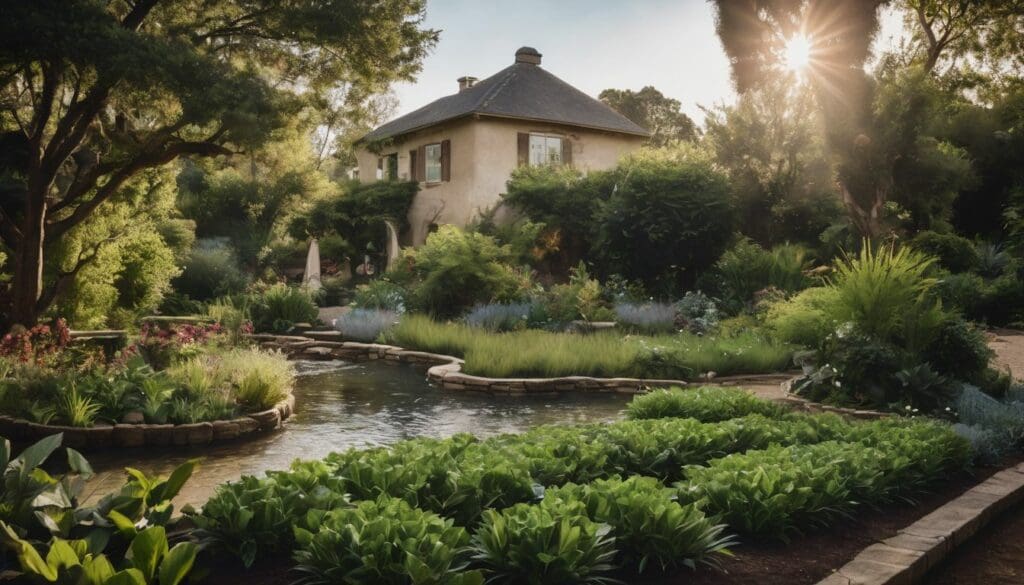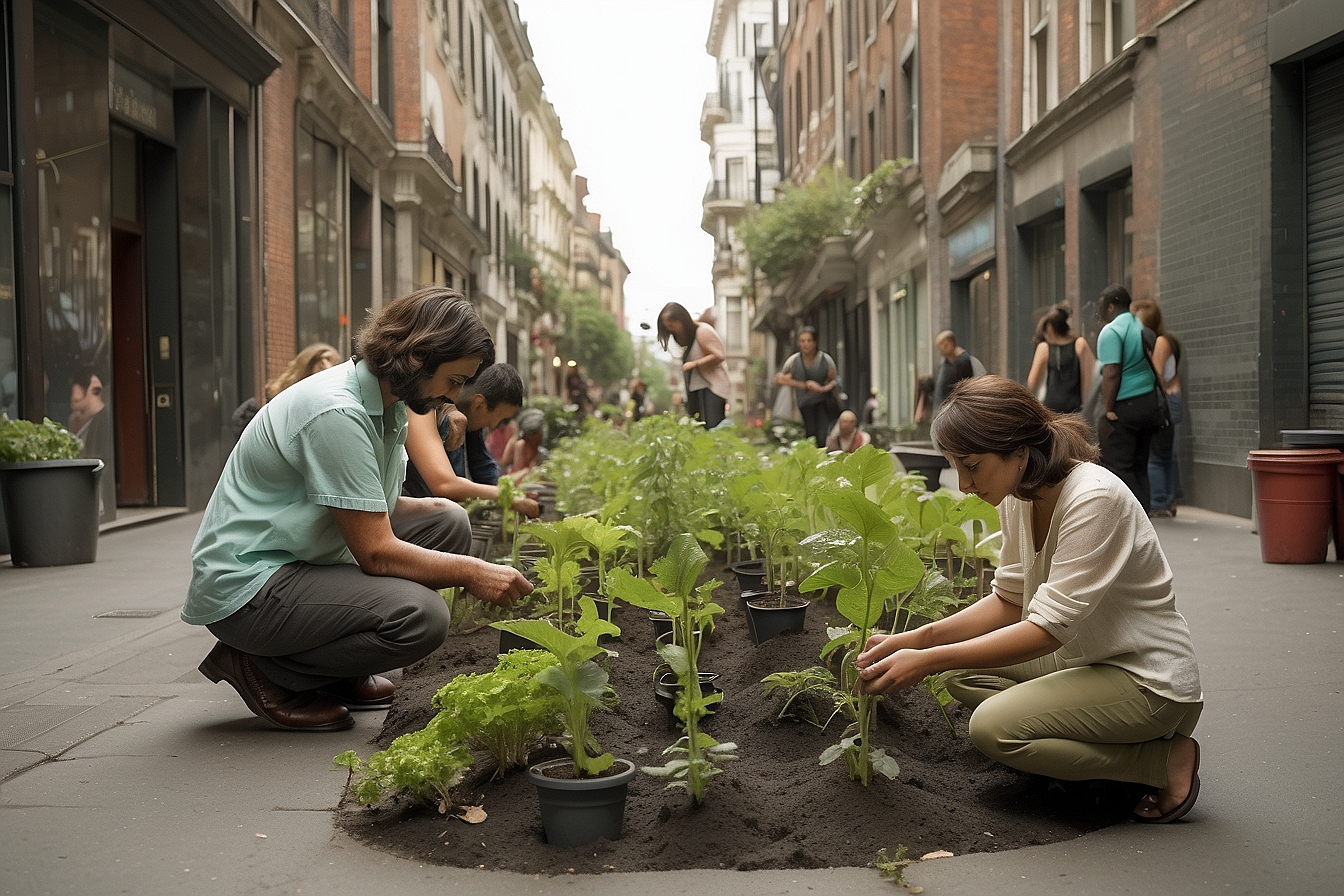Many of us fret over the footprint we leave on our dear planet, particularly when it comes to our cherished gardens and the spaces beyond our back doors. We wholeheartedly share these green-fingered concerns—traditional gardening does indeed have a rather thirsty side, guzzling some 9 billion gallons of water daily across the pond in the States.
Fear not, though! Our guide is brimming with nifty eco-friendly landscaping methods that promise to transform your patch into a flourishing retreat that’s kind to old Mother Earth.
So roll up your sleeves and dig into these pages; together we can cultivate change!
Key Takeaways
- Adopting eco – friendly landscaping methods like using native plants and minimising concrete can significantly reduce environmental impact.
- Permeable materials, green roofs, and rainwater harvesting are key sustainable hardscape options that help manage water resources wisely.
- Attracting wildlife with native plantings and providing habitats supports biodiversity and contributes to a balanced ecosystem in your garden.
- Mulching, allowing grass to grow longer for natural insulation, and employing water-saving irrigation techniques promote low-maintenance yet environmentally conscious gardening practices.
- Repurposing materials not only adds uniqueness to your garden but also aligns with reducing waste, conserving resources, and supporting sustainable living.
What is eco-friendly landscaping?
Eco-friendly landscaping involves using sustainable and environmentally friendly methods to design, create, and maintain outdoor spaces. This includes using native plants, minimising the use of concrete, reusing materials, and reducing waste and pollution.
Definition
We define eco-friendly landscaping as creating outdoor spaces that live in harmony with the natural environment. This kind of landscaping is mindful of the ecosystem and aims to preserve resources like water, soil, and energy.
It involves techniques that minimise harm to the earth while nurturing wildlife and plants native to the area.
Our focus goes beyond just planting greenery; we adopt sustainable practices such as xeriscaping, which reduces or eliminates the need for irrigation. We also employ organic materials, avoid harmful chemicals, and use permeable hardscapes that allow rainwater to replenish groundwater rather than running off into storm drains.
Through these methods, we create beautiful gardens that help sustain our planet’s health for future generations.
Benefits for the environment
Eco-friendly landscaping offers a range of benefits for the environment, such as:
- Conserving water through drought-resistant landscapes and rainwater harvesting, reducing strain on local water supplies.
- Creating habitats for wildlife and pollinators by incorporating native plants, promoting biodiversity and ecological balance.
- Minimising pollution with permeable hardscape materials that allow rainwater to infiltrate into the ground, preventing runoff into water bodies.
- Reducing energy consumption by implementing green roofs that provide natural insulation and improve air quality.
Designing a green landscape
When designing a green landscape, it’s important to consider using native plants, minimal concrete, and repurposing materials for a more sustainable and eco-friendly approach. This helps to create a natural and environmentally friendly outdoor space that benefits the local ecosystem.
Native plants
Using native plants in landscaping helps to support local ecosystems and biodiversity. These plants are naturally adapted to the climate and soil conditions of a specific region, making them low-maintenance and resilient.
By choosing native species, we can reduce water consumption, as these plants are already acclimated to the natural rainfall patterns in the area. Additionally, native plants provide food and shelter for local wildlife, supporting pollinators like bees and butterflies.
Incorporating a variety of native plants into our landscapes not only enhances the beauty of our outdoor spaces but also contributes to the overall health of our environment.
Incorporating native plants into your landscaping not only benefits the environment but also creates an attractive and sustainable outdoor space. When selecting plants for your yard or garden, consider including a diverse range of indigenous species that will thrive without excessive maintenance or resources.
Minimal concrete use
To complement the eco-friendly approach of using native plants, minimising concrete use in landscaping further reduces the environmental impact. Concrete has a high carbon footprint due to its manufacturing process and contributes to heat retention in urban areas.
Instead, consider incorporating alternative hardscape materials like gravel, wood chips, or permeable pavers. These options allow rainwater to seep into the ground rather than contributing to runoff and erosion.
Additionally, using innovative techniques such as creating pathways with reclaimed bricks or natural stone adds character and sustainability to outdoor spaces. By opting for minimal concrete use in your landscape design, you contribute to reducing urban heat islands and promoting healthier ecosystems while maintaining an aesthetically pleasing environment for all living creatures including humans and wildlife alike.
Reusing and repurposing materials
To reduce environmental impact, we repurpose and reuse materials in our landscaping projects. This approach minimises waste and promotes sustainability by giving new life to discarded items.
Reclaimed wood, old bricks, or salvaged metal can be transformed into eye-catching features such as planters, raised beds, or retaining walls. By integrating these elements into our designs, we contribute to conserving resources and reducing the demand for newly manufactured materials.
Our commitment to eco-friendly practices is evident in every aspect of our landscaping projects as we strive to create beautiful outdoor spaces while minimising environmental harm.
Sustainable hardscape options
When it comes to sustainable hardscape options, consider using permeable materials, implementing rainwater harvesting techniques, and even incorporating green roofs into your landscape design.
These eco-friendly options can help reduce water runoff and promote a healthier environment for all living creatures in your backyard.
Permeable materials
Permeable materials, such as permeable pavers and gravel, allow rainwater to soak into the ground instead of running off into storm drains. This helps prevent erosion, reduces flooding, and replenishes groundwater.
By using these materials in your landscape design, you can contribute to water conservation and create a more environmentally friendly outdoor space.
When designing with permeable materials, consider incorporating features like a rain garden or bioswale that will further enhance water infiltration and reduce the environmental impact of your landscaping choices.
Rainwater harvesting
Rainwater harvesting involves collecting and storing rainwater for later use. This sustainable practice helps to reduce the demand on local water supplies, especially during dry periods.
By capturing rainwater from roofs and other surfaces, it can be used for watering plants, washing cars, or even flushing toilets. Additionally, it reduces stormwater runoff which can carry pollutants into natural water bodies.
Implementing rainwater harvesting in your eco-friendly landscape allows you to take advantage of a free and abundant resource while reducing your environmental impact. You can easily incorporate this technique by installing a simple rain barrel or designing more complex systems that store larger amounts of water for various purposes.
Green roofs
Green roofs are an effective way to incorporate sustainability into urban environments. They help reduce the urban heat island effect and improve air quality by capturing pollutants.
Additionally, they provide insulation, reducing the need for heating and cooling, which ultimately lowers energy consumption.
Using green roofs can also mitigate stormwater runoff, as they absorb rainwater and decrease the burden on sewer systems. Moreover, they create habitats for birds and insects in areas where green space is limited, promoting biodiversity within city landscapes.
Practices to reduce waste and pollution
Implementing erosion control measures, using drought-resistant landscapes, and creating habitats to attract wildlife and pollinators are essential practices for reducing waste and pollution in your eco-friendly landscaping.
Read more about these techniques on our blog!
Erosion control
Implementing erosion control measures is vital for maintaining a sustainable and environmentally friendly landscape. By using natural barriers such as mulch, terracing, or retaining walls, we can prevent soil erosion and loss.
Planting deep-rooted vegetation like native grasses and shrubs also helps to anchor the soil in place and reduce runoff during heavy rainfall. Incorporating these strategies into our landscaping not only conserves the topsoil but also protects water quality by minimising sedimentation in nearby bodies of water.
To further promote a healthy and eco-friendly outdoor space, it is crucial to consider drought-resistant landscapes that require minimal watering while still thriving in their environment.
Integrating these practices into our landscaping efforts ensures that we are contributing positively to environmental conservation while creating beautiful, sustainable outdoor spaces.
Drought-resistant landscapes
To create drought-resistant landscapes, we can choose native plants that require minimal water and maintenance. Implementing mulch around plants helps retain soil moisture, decreasing the need for frequent watering.
Additionally, selecting climate-appropriate landscaping reduces water usage while maintaining an eco-friendly yard. Welcoming wildlife by providing a habitat in our gardens supports pollinators and creates a balanced ecosystem.
Installing rain barrels enables us to conserve rainwater, ensuring sustainable use during dry periods. Using permeable materials for driveways and walkways allows water to penetrate the ground rather than creating runoff, promoting healthy groundwater recharge.
These measures align with our commitment to ecoconscious landscaping practices and contribute to conservation efforts.
Attracting wildlife and pollinators
After establishing drought-resistant landscapes, it’s essential to consider attracting wildlife and pollinators to your eco-friendly yard. Incorporating native plants is a great way to create habitats for birds, butterflies, bees, and other beneficial insects.
Additionally, designating areas with wildflowers and flowering shrubs can provide food sources for these creatures while adding natural beauty to your landscape. Using organic fertilisers instead of chemical ones ensures that the environment remains safe for wildlife and helps maintain the natural balance within your outdoor space.
Moreover, providing bird feeders, bird baths, or creating small ponds can further encourage various species to visit your yard. These simple yet effective measures not only attract wildlife but also play a vital role in supporting local ecosystems and contributing to biodiversity conservation efforts in your area.
Tips for a low-maintenance eco-friendly backyard
For a low-maintenance eco-friendly backyard, consider using native plants, mulching to retain moisture and reduce weeds, allowing grass to grow slightly longer for natural shading and water-saving irrigation methods.
These simple tips can help create a sustainable outdoor space with minimal effort.
Choosing native plants
When choosing native plants, consider the local climate and soil conditions to ensure they thrive in your garden. Native plants are well-adapted to the environment, requiring less water and maintenance compared to non-native species.
They also provide essential habitat for local wildlife, supporting biodiversity in your area.
Opting for native plants promotes a healthier ecosystem and reduces the need for fertilisers or pesticides. Additionally, these plants contribute to preserving the natural heritage of your region while adding beauty and diversity to your landscape.
Using mulch
Mulch helps to retain soil moisture, suppress weeds, and regulate soil temperature. It also enriches the soil as it breaks down, reducing the need for fertilisers. Applying a 2-3 inch layer of mulch around plants can create an attractive yard and contribute to water conservation efforts.
Mulches made from natural materials like wood chips or bark are effective in controlling erosion while providing habitats for beneficial organisms.
Moreover, using organic mulch promotes the decomposition process returning nutrients into the soil, aiding plant growth without harming the environment. It’s best to replenish mulches annually by adding fresh layers since they naturally decompose over time.
High grass length
Maintaining a high grass length in our eco-friendly landscape not only adds natural beauty but also supports biodiversity. Longer grass provides habitat for insects, birds, and other wildlife.
This promotes a healthier ecosystem, encouraging pollinators and beneficial insects to thrive. Additionally, taller grass helps to prevent soil erosion by reducing water runoff and protecting the topsoil from being washed away during heavy rainfall.
Allowing the grass to grow longer also reduces the need for frequent mowing, which saves time and energy while benefitting the environment. By keeping a longer grass length, we can create a more sustainable and low-maintenance yard that contributes positively to our local ecosystem.
Water-saving irrigation methods
To efficiently water our landscape, we can implement drip irrigation systems which deliver water directly to the plant roots, minimising wastage. Installing soaker hoses is another effective way to ensure targeted watering and prevent run-off.
Additionally, using moisture sensors in our irrigation system allows us to tailor watering schedules according to the specific needs of our plants, reducing unnecessary water usage.
Using rainwater collected in barrels can supplement irrigation needs while reducing reliance on municipal water sources. Furthermore, grouping plants with similar water requirements together ensures that no area gets over or under-watered.
Installing rain barrels
Rain barrels are a great way to collect and store rainwater for later use. This eco-friendly practice helps conserve water and reduce runoff, benefiting both the environment and your wallet.
By installing rain barrels, you can easily capture water from your roof and gutters, which can then be used for watering plants, gardens, or even washing outdoor surfaces.
Installing rain barrels supports sustainable outdoor space design by promoting water conservation and reducing demand on local water supplies. This method aligns with environmentally friendly landscaping practices by utilising natural resources in an efficient manner while also minimising pollution caused by stormwater runoff.
Conclusion
In conclusion, eco-friendly landscaping practices benefit the environment by reducing waste and pollution. Sustainable hardscaping with permeable materials and rainwater harvesting contributes to water conservation.
By attracting wildlife and using native plants, you can create a low-maintenance yard that supports your local ecosystem. Implementing these techniques in your landscape design will help conserve natural resources while creating a beautiful and sustainable outdoor space.
FAQs
1. What are eco-friendly landscaping techniques?
Eco-friendly landscaping techniques focus on creating a garden that works with nature, using climate-appropriate plants and environmentally friendly methods to maintain your garden.
2. Can eco-landscaping save water?
Yes, through rainwater harvesting and employing low-impact landscaping strategies like choosing drought-tolerant plants, you can design a climate-friendly landscape that conserves water.
3. How does organic landscaping benefit the environment?
Organic landscaping avoids chemicals, relying instead on natural products for plant health which makes it safer for wildlife and reduces pollution in your eco-conscious garden.
4. What is eco-sensitive landscape design?
Eco-sensitive landscape design incorporates earth-friendly gardening tips such as conserving native flora and designing spaces that minimise disruption to the local ecosystem.
5. Are there ways to have a low-maintenance garden but still be green?
Certainly! Eco-friendly gardens often require less upkeep by utilising low-maintenance practices like mulching and using perennial plants that adapt well to local conditions.





